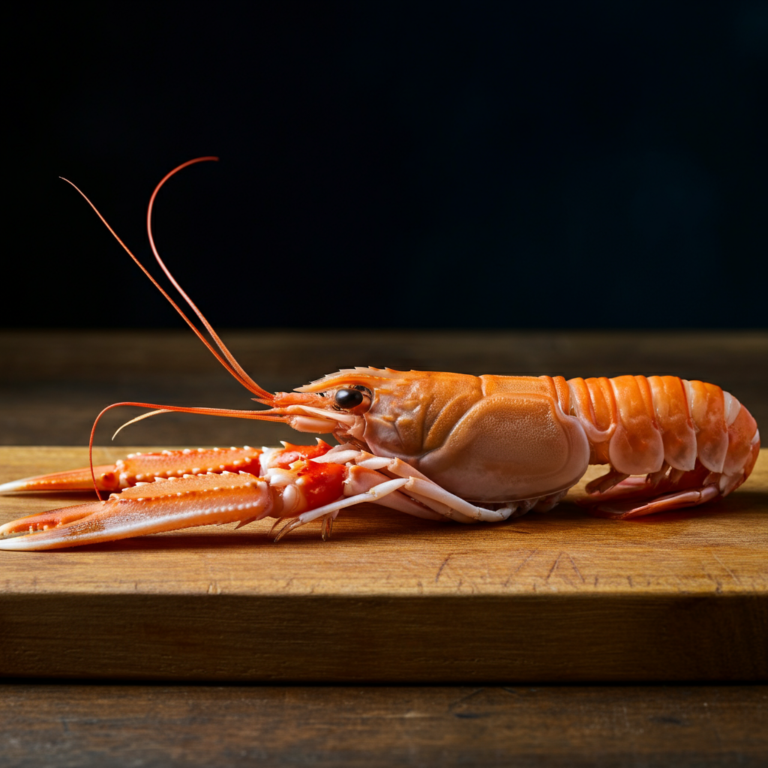What Are Langoustines?
Langoustines, scientifically known as Nephrops norvegicus, are small, slim, coral-colored lobsters found in the cold waters of the North Atlantic. Sometimes referred to as Norway lobster, Dublin Bay prawn, or scampi, they grow up to 10 inches in length and are prized for their sweet, tender meat.
Unlike larger lobsters, which are sought after for their size and strength, langoustines are delicate in flavor and physical structure. They are a staple ingredient in many European fine-dining dishes, particularly in Italy, Spain, and France, where their petite size and refined flavor align perfectly with haute cuisine principles.
Langoustine vs. Other Crustaceans
Langoustines are often compared to shrimp and lobster, but they sit somewhere between the two in taste and appearance.
-
- Physical Differences: Langoustines are smaller than traditional lobsters and have a slender body with long, narrow pincers.
- Their coral-pink shell is more vibrant than lobsters’ typical brown or red shells.
- They’re more extensive and structured than shrimp but lack the robustness of lobster claws.
- Taste and Texture: Langoustine meat tastes closer to lobster but sweeter and more delicate.
- Compared to shrimp, its texture is firmer and less chewy, offering a refined eating experience.
- Status and Price: Langoustines are considered a high-end delicacy, often commanding a higher price than lobster due to their limited habitat and unique flavor profile. Their rarity and small yield per catch further drive their exclusive appeal.
The Culinary Appeal of Langoustine
A Unique Flavor Profile
Langoustine meat is tender and sweet, often described as a “luxury version” of lobster. Its flavor is subtler, with notes of the sea that pair beautifully with various seasonings and accompaniments. These attributes make it a favorite among chefs, who use it to elevate their culinary creations.
Cooking Methods and Applications
Langoustines are highly versatile and can be prepared in numerous ways:
- Grilling: A quick sear on the grill brings out their natural sweetness.
- Boiling or Steaming: Cooking them in salted water preserves their delicate texture and taste.
- Sautéing or Pan-Frying: This method is best for dishes like pasta or risotto, where the savory juices can enhance the flavor.
- Raw Preparations: While langoustine can be consumed raw, provided it’s fresh and properly handled, it’s most commonly blanched to achieve that perfect balance of flavor and texture.
- Popular raw dishes include langoustine carpaccio or sashimi, typically served with light seasonings like olive oil and sea salt.
Dishes Featuring Langoustine
Iconic in haute cuisine, langoustine is featured in various exquisitely crafted dishes, from seafood paellas and French bisques to Italian pasta and Spanish tapas. Its versatility allows it to shine as the star ingredient or as part of a luxurious medley.
Habitat and Availability
Langoustines inhabit the cold, clear waters of the North Atlantic, particularly near Scotland, Ireland, and Scandinavia. This limited geographic habitat contributes to their exclusivity and higher price tag. Scotland, in particular, plays a significant role in global supply, responsible for nearly half of the world’s langoustine exports.
Their wild-caught nature and relatively short supply also influence their premium pricing. Unlike farm-raised seafood, langoustines rely entirely on sustainable fishing practices, adding value for conscious consumers.
Sourcing Langoustine Sustainably
Langoustines are primarily wild-caught, which means their supply is somewhat unpredictable. However, sustainable fishing practices ensure their continued availability. Consumers should seek suppliers that use ethical fishing methods and support well-managed fisheries.
Frozen langoustines are also an excellent option. With advances in flash-freezing technology, frozen langoustines can be just as fresh as those sold live and are often easier to source.
Why Add Langoustine to Your Diet?
Beyond their culinary allure, langoustines offer numerous health benefits:
-
- Rich in Omega-3s: Langoustines are packed with omega-3 fatty acids, which are excellent for heart health and reducing inflammation.
- Low in Calories: Despite their rich flavor, langoustines are relatively low in calories, making them an indulgent yet health-conscious choice.
- Nutrient Dense: They provide essential nutrients, including protein, vitamins B12 and E, and selenium, a mineral known for its antioxidant properties.
By incorporating langoustines into your diet, you can enjoy a gourmet dining experience and reap valuable nutritional rewards.
FAQs About Langoustine
Is langoustine a shrimp or a lobster?
Langoustines are part of the lobster family but are smaller and have a slimmer, more shrimp-like appearance. They’re often called “the shrimp of the lobster world.”
Why are langoustines so expensive?
Langoustines are expensive due to their limited habitat, challenging harvesting processes, and high demand for fine dining. Their rarity elevates their price.
What does langoustine taste like?
Langoustines have a delicate, sweet flavor similar to lobster but with a firmer texture and a slightly refined taste. Smaller langoustines are often regarded as the most flavorful.
Can you eat langoustine raw?
While consuming raw langoustine is possible, it’s essential to ensure it’s fresh and handled correctly to avoid food-borne illnesses. Lightly cooking or blanching is often recommended for the best flavor and safety.
How do you know when langoustine is cooked?
When cooked, langoustine flesh transitions from translucent to opaque white. Avoid overcooking, as it can toughen the delicate meat.
Where do langoustines come from?
Langoustines are wild-caught from the cold waters of the North Atlantic, with Scotland being a major supplier. They thrive in well-managed, sustainable fisheries.
Why Langoustine Deserves Its Haute Cuisine Status
Langoustines are more than just a crustacean—they’re a culinary treasure. Everything about langoustine exudes elegance, from its tender, sweet meat to its luxurious price point. Whether you’re a fine-dining aficionado or a seafood enthusiast, incorporating langoustine into your culinary adventures is a rewarding experience.
If you’re unfamiliar with this delightful crustacean, now’s the time to explore. Whether grilled, boiled, or raw, langoustine will elevate any meal to a gourmet masterpiece.
